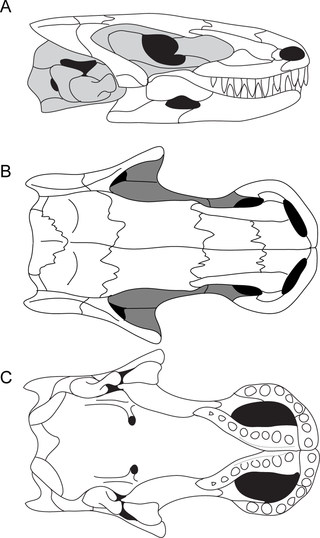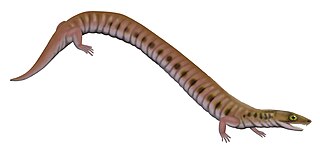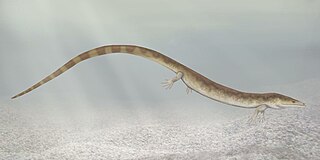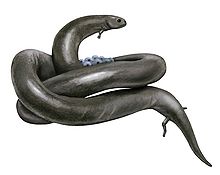
Caecilians are a group of limbless, vermiform (worm-shaped) or serpentine (snake-shaped) amphibians with small or sometimes nonexistent eyes. They mostly live hidden in soil or in streambeds, and this cryptic lifestyle renders caecilians among the least familiar amphibians. Modern caecilians live in the tropics of South and Central America, Africa, and southern Asia. Caecilians feed on small subterranean creatures such as earthworms. The body is cylindrical and often darkly coloured, and the skull is bullet-shaped and strongly built. Caecilian heads have several unique adaptations, including fused cranial and jaw bones, a two-part system of jaw muscles, and a chemosensory tentacle in front of the eye. The skin is slimy and bears ringlike markings or grooves and may contain scales.

The Batrachia are a clade of amphibians that includes frogs and salamanders, but not caecilians nor the extinct allocaudates. The name Batrachia was first used by French zoologist Pierre André Latreille in 1800 to refer to frogs, but has more recently been defined in a phylogenetic sense as a node-based taxon that includes the last common ancestor of frogs and salamanders and all of its descendants. The idea that frogs and salamanders are more closely related to each other than either is to caecilians is strongly supported by morphological and molecular evidence; they are, for instance, the only vertebrates able to raise and lower their eyes. However, an alternative hypothesis exists in which salamanders and caecilians are each other's closest relatives as part of a clade called the Procera, with frogs positioned as the sister taxon of this group.

"Labyrinthodontia" is an informal grouping of extinct predatory amphibians which were major components of ecosystems in the late Paleozoic and early Mesozoic eras. Traditionally considered a subclass of the class Amphibia, modern classification systems recognize that labyrinthodonts are not a formal natural group (clade) exclusive of other tetrapods. Instead, they consistute an evolutionary grade, ancestral to living tetrapods such as lissamphibians and amniotes. "Labyrinthodont"-grade vertebrates evolved from lobe-finned fishes in the Devonian, though a formal boundary between fish and amphibian is difficult to define at this point in time.

Lepospondyli is a diverse taxon of early tetrapods. With the exception of one late-surviving lepospondyl from the Late Permian of Morocco, lepospondyls lived from the Early Carboniferous (Mississippian) to the Early Permian and were geographically restricted to what is now Europe and North America. Five major groups of lepospondyls are known: Adelospondyli; Aïstopoda; Lysorophia; Microsauria; and Nectridea. Lepospondyls have a diverse range of body forms and include species with newt-like, eel- or snake-like, and lizard-like forms. Various species were aquatic, semiaquatic, or terrestrial. None were large, and they are assumed to have lived in specialized ecological niches not taken by the more numerous temnospondyl amphibians that coexisted with them in the Paleozoic. Lepospondyli was named in 1888 by Karl Alfred von Zittel, who coined the name to include some tetrapods from the Paleozoic that shared some specific characteristics in the notochord and teeth. Lepospondyls have sometimes been considered to be either related or ancestral to modern amphibians or to Amniota. It has been suggested that the grouping is polyphyletic, with aïstopods being primitive stem-tetrapods, while recumbirostran microsaurs are primitive reptiles.
Lysorophia is an order of fossorial Carboniferous and Permian tetrapods within the Recumbirostra. Lysorophians resembled small snakes, as their bodies are extremely elongate. There is a single family, the Molgophidae. Currently there are around five genera included within Lysorophia, although many may not be valid.

Diplocaulus is an extinct genus of lepospondyl amphibians which lived from the Late Carboniferous to the Late Permian of North America and Africa. Diplocaulus is by far the largest and best-known of the lepospondyls, characterized by a distinctive boomerang-shaped skull. Remains attributed to Diplocaulus have been found from the Late Permian of Morocco and represent the youngest-known occurrence of a lepospondyl.

Microsauria is an extinct, possibly polyphyletic order of tetrapods from the late Carboniferous and early Permian periods. It is the most diverse and species-rich group of lepospondyls. Recently, Microsauria has been considered paraphyletic, as several other non-microsaur lepospondyl groups such as Lysorophia seem to be nested in it. Microsauria is now commonly used as a collective term for the grade of lepospondyls that were originally classified as members of Microsauria.

Gerobatrachus is an extinct genus of amphibamid temnospondyl that lived in the Early Permian, approximately 290 million years ago (Ma), in the area that is now Baylor County, Texas. When it was first described in 2008, Gerobatrachus was announced to be the closest relative of Batrachia, the group that includes modern frogs and salamanders. It possesses a mixture of characteristics from both groups, including a large frog-like head and a salamander-like tail. These features have led to it being dubbed a frogamander by the press. Some more recent studies place Gerobatrachus as the closest relative of Lissamphibia, the group that contains all modern amphibians including frogs, salamanders, and caecilians, or place modern amphibians far from Gerobatrachus within a group called Lepospondyli.

Brachydectes is an extinct genus of lysorophian tetrapods that lived from the Late Carboniferous to the Early Permian. It had a very small head and long body, B. elongatus had 1–2 centimetres (0.39–0.79 in) long skull and pre-sacral length up to 150 centimetres (59 in), while B. newberryi, which have proportionally larger skull than B. elongatus, for specimen with 7.6 millimetres (0.30 in) skull roof had estimated total length of 11 centimetres (4.3 in), while the largest skull exceeds 3 centimetres (1.2 in).

Colobomycter is an extinct genus of lanthanosuchoid parareptile known from the Early Permian of Oklahoma.

Acherontiscus is an extinct genus of stegocephalians that lived in the Early Carboniferous of Scotland. The type and only species is Acherontiscus caledoniae, named by paleontologist Robert Carroll in 1969. Members of this genus have an unusual combination of features which makes their placement within amphibian-grade tetrapods uncertain. They possess multi-bone vertebrae similar to those of embolomeres, but also a skull similar to lepospondyls. The only known specimen of Acherontiscus possessed an elongated body similar to that of a snake or eel. No limbs were preserved, and evidence for their presence in close relatives of Acherontiscus is dubious at best. Phylogenetic analyses created by Marcello Ruta and other paleontologists in the 2000s indicate that Acherontiscus is part of Adelospondyli, closely related to other snake-like animals such as Adelogyrinus and Dolichopareias. Adelospondyls are traditionally placed within the group Lepospondyli due to their fused vertebrae. Some analyses published since 2007 have argued that adelospondyls such as Acherontiscus may not actually be lepospondyls, instead being close relatives or members of the family Colosteidae. This would indicate that they evolved prior to the split between the tetrapod lineage that leads to reptiles (Reptiliomorpha) and the one that leads to modern amphibians (Batrachomorpha). Members of this genus were probably aquatic animals that were able to swim using snake-like movements.

Euryodus is an extinct genus of microsaur within the family Gymnarthridae. Euryodus is a Lepospondyl from the clade Microsauria that lived during the Lower Permian. The name comes from Greek, meaning ‘broad-tooth’. It has been found in the southern half of North America, from its original discovery in Texas up to Utah.
Megamolgophis is an extinct genus of eel-like tetrapod, possibly belonging to the group Lysorophia. Fossils from this genus have been found in the Allegheny mountains of the eastern United States. The genus is endemic to geological formations of this area, such as the Greene and Washington formations of the Early Permian Dunkard Group, as well as the Pennsylvanian Conemaugh Group.

Rhynchonkos is an extinct genus of rhynchonkid microsaur. Originally known as Goniorhynchus, it was renamed in 1981 because the name had already been given to another genus; the family, likewise, was originally named Goniorhynchidae but renamed in 1988. The type and only known species is R. stovalli, found from the Early Permian Fairmont Shale in Cleveland County, Oklahoma. Rhynchonkos shares many similarities with Eocaecilia, an early caecilian from the Early Jurassic of Arizona. Similarities between Rhynchonkos and Eocaecilia have been taken as evidence that caecilians are descendants of microsaurs. However, such a relationship is no longer widely accepted.
Altenglanerpeton is an extinct genus of microsaur tetrapod from the Late Carboniferous or Early Permian of Germany. Altenglanerpeton was named in 2012 after the Altenglan Formation in which it was found. The type and only species is A. schroederi.

Recumbirostra is a clade of tetrapods which lived during the Carboniferous and Permian periods. They are thought to have had a fossorial (burrowing) lifestyle and the group includes both short-bodied and long-bodied snake-like forms. At least one species, the long-bodied molgophid Nagini mazonense, lost its forelimbs entirely. Recumbirostra includes the families Pantylidae, Gymnarthridae, Ostodolepidae, Rhynchonkidae and Brachystelechidae, with additional families such as Microbrachidae and Molgophidae being included by some authors. Brachystelechidae and Molgophidae have also been grouped together in the suggested clade Chthonosauria.

The Urocordylidae are an extinct family of nectridean lepospondyl amphibians. Urocordylids lived during the Late Carboniferous and Early Permian in what is now Europe and North America and are characterized by their very long, paddle-like tails. In life, they were probably newt-like and aquatic.
Ductilodon is an extinct genus of lepospondyl amphibian in the family Diplocaulidae. The type and only species Ductilodon pruitti was named in 1999 from the Early Permian of Kansas. Distinguishing features of Ductilodon include horns that project backward from the skull and an arched row of teeth on the palate. Ductilodon is most closely related to the diplocaulids Diplocaulus and Diploceraspis.
Proxilodon is an extinct genus of recumbirostran microsaur from the Early Permian Speiser Formation of Kansas, United States. It contains a single species, Proxilodon bonneri,.

Opisthodontosaurus is an extinct genus of captorhinid reptile from the Early Permian of Oklahoma. The type species Opisthodontosaurus carrolli was named in 2015 on the basis of several articulated skeletons from the Dolese Brothers Limestone Quarry near Richards Spur. Before the description of these skeletons, the jaws and teeth of Opisthodontosaurus carrolli were thought to belong to a species of lepospondyl amphibian called Euryodus primus. Although captorhinid reptiles and lepospondyl amphibians are distantly related, the two species show a remarkable degree of evolutionary convergence in their dental anatomy. Both were likely durophagous, eating hard-shelled invertebrates.



















